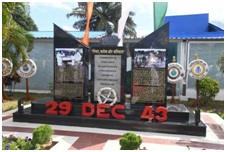Context
Recently, Commander-in-Chief Andaman and Nicobar Command (CINCAN) has inaugurated Sankalp Smarak at Andaman and Nicobar Islands.
What is Sankalp Smarak?
- Sankalp Smarak is a monument dedicated to Netaji Subhas Chandra Bose.
- It is a tribute not only to the resolve of the soldiers of the Indian National Army and their innumerable sacrifices but also reminds us of the values enshrined by Netaji himself.

|
Subhash Chandra Bose
- Netaji Subhas Chandra Bose (23rd January 1897 – 18th August 1945) is one of the most celebrated freedom fighters of India.
- In 1942, he earned the title ‘Netaji’, in Germany by the Indian soldiers of the Azad Hind Fauj.
- Bose is credited with the very famous slogan, “Give me blood, and I shall give you freedom!” as well as “Jai Hind”.
- He is also credited to be the first man to call Mahatma Gandhi “Father of the Nation”, in his address from Singapore.
|
Netaji Subhash Chandra Bose & Andaman and Nicobar Islands
- During World War II (1942–45), Japan had conquered the Andaman and Nicobar Islands from the British and handed it over to Netaji and his army, the Azad Hind Fauj.
- Netaji then arrived at Andaman and Nicobar Island on 29th December 1943 and declared the island free from British rule, much before India got its Independence in 1947.
- On the next day,Netaji hoisted the national flag for the first time on Indian soil, at Port Blair.
- During his visit, he also visited the Cellular Jail and met the freedom fighters lodged there.
- Before his departure, he renamed Andaman as Shaheed (“Martyrs”) Island, and Nicobar as Swaraj (“Freedom”) Island.
Significance of Netaji’s visit
- Firstly, Netaji’s visit to the Andaman and Nicobar Islands as the Head of the Provisional Government of Azad Hind and Supreme Commander of the Indian National Army marked a symbolic fulfilment of his promise that the Indian National Army would stand on Indian soil by the end of 1943.
- Secondly, this historic visit also marked a declaration of Andaman and Nicobar Islands as the “first liberated territory of India”.
